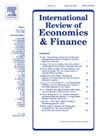绿色金融政策对污染和碳减排的协同效应:一个准实验设计
IF 5.6
2区 经济学
Q1 BUSINESS, FINANCE
引用次数: 0
摘要
绿色金融改革与创新试点政策(PPGFRI)在中国绿色金融框架和追求污染与碳减排(PCR)目标中发挥着关键作用。本研究构建了包含碳减排、空气质量和PCR协同效应指标的多维环境绩效评价体系,以评估PPGFRI的影响。本文采用交错差中差模型,分析了2010年至2022年中国285个地级市的面板数据。我们的研究结果表明,PPGFRI不仅有效地减少了碳排放,改善了空气质量,而且显著增强了PCR的协同效应。渠道分析表明,PPGFRI通过促进技术研发、绿色创新和人力资本积累实现了这些成果。异质性分析表明,PPGFRI在所有试点城市的碳减排和空气质量改善方面均表现出显著的单边效应,而协同PCR效应在东部地区和发达城市更为明显。此外,产业结构显著影响政策有效性:PPGFRI在第二产业主导的城市改善了空气质量,但对碳减排产生了负面影响,而在其他城市,PPGFRI在两个维度上都表现良好。此外,我们发现数字鸿沟和传统城市基础设施对PPGFRI的协同效应有负向调节作用,而农业保险对PPGFRI的协同效应有正向调节作用。这些发现为完善中国和其他发展中国家的绿色金融政策、推进综合污染控制和碳减排战略提供了宝贵的见解。本文章由计算机程序翻译,如有差异,请以英文原文为准。
The collaborative effect of green finance policy on pollution and carbon reduction: A quasi-experimental design
The pilot policy for green finance reform and innovation (PPGFRI) plays a pivotal role in China's green finance framework and the pursuit of pollution and carbon reduction (PCR) goals. This study constructs a multidimensional environmental performance evaluation system, encompassing carbon reduction, air quality, and collaborative effect indicators of the PCR, to assess the impact of PPGFRI. Using a staggered difference-in-differences model, this paper analyzes panel data from 285 Chinese prefecture-level cities spanning 2010 to 2022. Our findings reveal that PPGFRI not only effectively reduces carbon emissions and improves air quality but also significantly enhances the collaborative effect of PCR. Channel analysis indicates that PPGFRI achieves these outcomes through promoting technological R&D, green innovation, and human capital accumulation. Heterogeneity analysis demonstrates that while PPGFRI shows significant unilateral effects in carbon reduction and air quality improvement across all pilot cities, the collaborative PCR effect is more pronounced in eastern regions and developed cities. Furthermore, this study identifies that industrial structure significantly influences policy effectiveness: PPGFRI improves air quality in secondary industry-dominated cities but negatively impacts carbon reduction, whereas it performs well in both dimensions for other cities. Additionally, we uncover that the digital divide and traditional urban infrastructure negatively moderate PPGFRI's collaborative effects, while agricultural insurance plays a positive moderating role. These findings offer valuable insights for refining green finance policies and advancing integrated pollution control and carbon reduction strategies in China and other developing nations.
求助全文
通过发布文献求助,成功后即可免费获取论文全文。
去求助
来源期刊
CiteScore
7.30
自引率
2.20%
发文量
253
期刊介绍:
The International Review of Economics & Finance (IREF) is a scholarly journal devoted to the publication of high quality theoretical and empirical articles in all areas of international economics, macroeconomics and financial economics. Contributions that facilitate the communications between the real and the financial sectors of the economy are of particular interest.

 求助内容:
求助内容: 应助结果提醒方式:
应助结果提醒方式:


